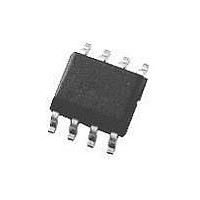LM2594HVM-ADJ National Semiconductor, LM2594HVM-ADJ Datasheet - Page 20

LM2594HVM-ADJ
Manufacturer Part Number
LM2594HVM-ADJ
Description
DC/DC Converter IC
Manufacturer
National Semiconductor
Datasheets
1.LM2594HVM-ADJ.pdf
(28 pages)
2.LM2594HVM-ADJ.pdf
(28 pages)
3.LM2594HVM-ADJ.pdf
(28 pages)
Specifications of LM2594HVM-ADJ
Input Voltage
60V
Output Current
500mA
Output Voltage
57V
No. Of Pins
8
Mounting Type
Surface Mount
Voltage Regulator Type
Buck Switching
Output Current Max
0.5A
Peak Reflow Compatible (260 C)
No
Lead Free Status / RoHS Status
Contains lead / RoHS non-compliant
Available stocks
Company
Part Number
Manufacturer
Quantity
Price
Company:
Part Number:
LM2594HVM-ADJ
Manufacturer:
nstion
Quantity:
1 467
Part Number:
LM2594HVM-ADJ
Manufacturer:
NS
Quantity:
20 000
Company:
Part Number:
LM2594HVM-ADJ/NOPB
Manufacturer:
TI
Quantity:
2 400
www.national.com
Application Information
By allowing the percentage of inductor ripple current to in-
crease for low load currents, the inductor value and size can
be kept relatively low.
When operating in the continuous mode, the inductor current
waveform ranges from a triangular to a sawtooth type of
waveform (depending on the input voltage), with the average
value of this current waveform equal to the DC output load
current.
Inductors are available in different styles such as pot core,
toroid, E-core, bobbin core, etc., as well as different core ma-
terials, such as ferrites and powdered iron. The least expen-
sive, the bobbin, rod or stick core, consists of wire wrapped
on a ferrite bobbin. This type of construction makes for a in-
expensive inductor, but since the magnetic flux is not com-
pletely contained within the core, it generates more
Electro-Magnetic Interference (EMl). This magnetic flux can
induce voltages into nearby printed circuit traces, thus caus-
ing problems with both the switching regulator operation and
nearby sensitive circuitry, and can give incorrect scope read-
ings because of induced voltages in the scope probe. Also
see section on Open Core Inductors.
The inductors listed in the selection chart include ferrite
E-core construction for Schott, ferrite bobbin core for Renco
and Coilcraft, and powdered iron toroid for Pulse Engineer-
ing.
Exceeding an inductor’s maximum current rating may cause
the inductor to overheat because of the copper wire losses,
or the core may saturate. If the inductor begins to saturate,
the inductance decreases rapidly and the inductor begins to
look mainly resistive (the DC resistance of the winding). This
can cause the switch current to rise very rapidly and force
the switch into a cycle-by-cycle current limit, thus reducing
the DC output load current. This can also result in overheat-
ing of the inductor and/or the LM2594. Different inductor
types have different saturation characteristics, and this
should be kept in mind when selecting an inductor.
The inductor manufacturers data sheets include current and
energy limits to avoid inductor saturation.
DISCONTINUOUS MODE OPERATION
The selection guide chooses inductor values suitable for
continuous mode operation, but for low current applications
and/or high input voltages, a discontinuous mode design
(as a Percentage of the Load Current) vs Load Current
FIGURE 16. ( I
Inductor Ripple Current
IND
) Peak-to-Peak
(Continued)
DS012439-31
20
may be a better choice. It would use an inductor that would
be physically smaller, and would need only one half to one
third the inductance value needed for a continuous mode de-
sign. The peak switch and inductor currents will be higher in
a discontinuous design, but at these low load currents
(200 mA and below), the maximum switch current will still be
less than the switch current limit.
Discontinuous operation can have voltage waveforms that
are considerable different than a continuous design. The out-
put pin (switch) waveform can have some damped sinusoi-
dal ringing present. (See photo titled; Discontinuous Mode
Switching Waveforms) This ringing is normal for discontinu-
ous operation, and is not caused by feedback loop instabili-
ties. In discontinuous operation, there is a period of time
where neither the switch or the diode are conducting, and
the inductor current has dropped to zero. During this time, a
small amount of energy can circulate between the inductor
and the switch/diode parasitic capacitance causing this char-
acteristic ringing. Normally this ringing is not a problem, un-
less the amplitude becomes great enough to exceed the in-
put voltage, and even then, there is very little energy present
to cause damage.
Different inductor types and/or core materials produce differ-
ent amounts of this characteristic ringing. Ferrite core induc-
tors have very little core loss and therefore produce the most
ringing. The higher core loss of powdered iron inductors pro-
duce less ringing. If desired, a series RC could be placed in
parallel with the inductor to dampen the ringing. The com-
puter aided design software Switchers Made Simple (ver-
sion 4.1) will provide all component values for continuous
and discontinuous modes of operation.
OUTPUT VOLTAGE RIPPLE AND TRANSIENTS
The output voltage of a switching power supply operating in
the continuous mode will contain a sawtooth ripple voltage at
the switcher frequency, and may also contain short voltage
spikes at the peaks of the sawtooth waveform.
The output ripple voltage is a function of the inductor saw-
tooth ripple current and the ESR of the output capacitor. A
typical output ripple voltage can range from approximately
0.5% to 3% of the output voltage. To obtain low ripple volt-
age, the ESR of the output capacitor must be low, however,
caution must be exercised when using extremely low ESR
capacitors because they can affect the loop stability, result-
ing in oscillation problems. If very low output ripple voltage is
needed (less than 15 mV), a post ripple filter is recom-
mended. (See Figure 1 .) The inductance required is typically
between 1 µH and 5 µH, with low DC resistance, to maintain
good load regulation. A low ESR output filter capacitor is also
required to assure good dynamic load response and ripple
FIGURE 17. Post Ripple Filter Waveform
DS012439-32











